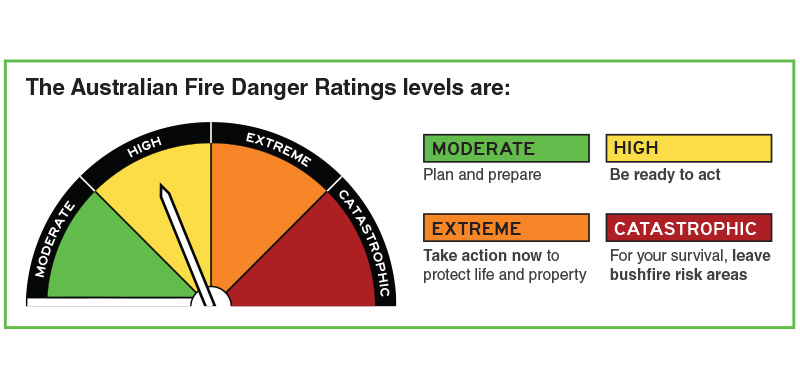On 1 September 2022, the Australian Fire Danger Rating System (AFDRS) was launched in Australia. It was the result of national collaboration with all states and territories working to develop a consistent and national fire danger rating system.
Fire danger ratings describe the potential level of danger should a bushfire start. These ratings are important because they provide people with information so they can take action to protect themselves and others from potentially dangerous bushfires.
The AFDRS replaces the current system developed in the 1960s. By using the latest science, data and technology and by having a better understanding of community needs, the AFDRS will improve public safety and reduce the effects of bushfires by:
- improving the scientific accuracy behind fire danger predictions
- improving the ways fire danger is communicated
- providing government and industry with better decision-making tools to support their management of bushfire.
Nationally consistent levels and action-oriented messaging
The new fire danger rating system has 4 levels that have action-oriented messages to encourage people to take action to protect themselves and others during times of heightened bushfire risks. The AFDRS also introduces ‘no rating’ for days where no proactive action is required by a community. This does not mean that fires cannot happen, but that they are not likely to move or act in a way that threatens the safety of communities.
All Australian jurisdictions will display the fire danger ratings in a consistent way, including using similar colours and roadside signage design. The design was decided following a very large survey of communities and supplemented by extensive focus groups. These studies revealed that most participants did not understand the previous system.

The Australian Fire Danger Rating System standardises the determining of the risk and how it is communicated.
Image: AFAC
Fewer levels of fire danger rating
Australia’s bushfire agencies, led by the NSW Rural Fire Service, worked to test, improve and retest the evidence that predicts fire danger. The previous system was developed in the 1960s and only considered how a fire might burn in forest or grass areas. The new fire danger ratings consider 8 different fuel vegetation types, including mallee heath, button grass and spinifex, and factors how much fuel is in an area and how long it has been since the last fire.
Through these expansions in what is considered to make a rating, local fire services agencies are able to better predict risk for communities and can help people to prepare. In determining a fire danger rating, fire services agencies will have greater insights as to where the areas of most concern are and can allocate resources to extinguishing fires faster.
Better decision-making tools
The AFDRS introduces the Fire Behaviour Index as a scale of fire danger that produces fine-scale information across the fuel types, the fuel loads, the time since the last fire as well as weather data to build better predictions. Because the index is provided at such a fine scale and considers so many variables, the AFDRS better supports decision-making for a range of activities such as harvesting regulations, operational activities, prescribed burning plans and suppression tactics. This significantly reduces over-regulation and over-warning and can also avoid the need to shut down activities unnecessarily.

The Fire Behaviour Index value determines the fire danger rating level.
Image: AFAC
The improved AFDRS reflects our advancements in understanding fire behaviour, delivering a more accurate reading of fire danger across all Australian landscapes and vegetation types. To ensure these improvements continue, the AFDRS has been designed to be updatable, allowing the system can take advantage of new science, data and information into the future.
Across the country, fire and emergency services are applying nationally consistent colours, signs and terminology to communicate fire danger risk. This means that wherever you go in Australia, and whatever the season or fuels you’re surrounded by, you can understand the level of threat and what you need to do to stay safe. The key benefit is a more prepared and resilient community resulting in a reduction in loss of life, property and human harm.


